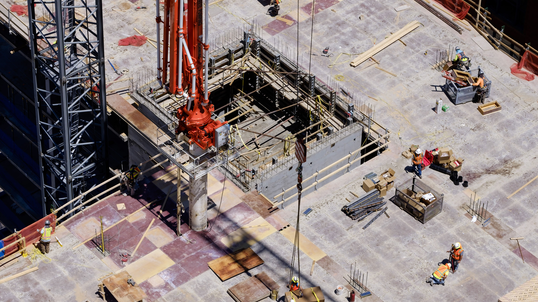How General Contractors Can Help Safeguard Against Pollution Liability with Subcontractors


Pollution risks can jeopardize the financial and reputational well-being of a general contractor’s business, even when the construction operations are performed by a subcontractor. Proper risk management, risk transfer strategies and insurance coverage can mitigate these threats.
Pollution hazards
Contractors working on construction projects may create or uncover existing pollution conditions that put the general contractor (GC) at risk.
Construction pollution exposures can result from operations, transportation or waste disposal and can come in many forms, such as:
- Diesel fuel, used by heavy equipment and trucks, that leaks and can affect soil as well as ground and surface water.
- Lead, silica dust and asbestos when released into the air, as well as hazardous fumes.
- Contaminated job site runoff, hazardous material/waste on-site storage or underground utility (sewer, natural gas) line ruptures or releases from damaged underground storage tanks.
- Fungi/mold and bacteria, which can lead to bodily injury or costly property damage and cleanup/decontamination.
- Spills of hazardous materials or waste during transportation.
Construction pollution prevention – risk management strategies
Early and ongoing mitigation efforts may help reduce the pollution exposures general contractors face when working with subcontractors. Consider the following practices to help reduce the risk of job site pollution:
- Awareness training and safety policies, procedures and practices (e.g., hazard communication in a health and safety plan).
- Formal subcontractor prequalification helps ensure that subcontractors are authorized, with the appropriate experience, training, skills and credentials, to properly complete the job. For example, when asked to hire an environmental contractor who specializes in services such as asbestos and lead abatement or mold and contaminated soil remediation, a GC should ensure that the contractor is qualified and licensed/certified to do the work and that they have provided acceptable evidence of pollution liability coverage, including Additional Insured status in favor of the GC and policy limits meeting the GC’s requirements.
- Consistent, ongoing oversight by a qualified, experienced representative of the GC is essential. Provide program administration with a formal, written quality assurance/quality control (QA/QC) program naming the individuals with QA/QC responsibilities and accountability. Ensure that materials and workmanship comply with building codes, design specifications and national standards as part of an effective oversight practice. Another GC best practice is to obtain and retain copies of written, third-party sign-off on any RFIs/changes to the scope of work.
- Finally, documentation can be the key to successful defense against pollution liability claims. Lack of follow-up and documentation, even with a contract in place, can create significant issues in a claim situation, particularly with environmental losses, which can be severe and complex. Effective, thorough document retention policies and procedures can significantly improve the chances of achieving the best possible outcome in a claim situation.
The right insurance coverage, including a contractors pollution liability policy, and proof of insurance from subcontractors, helps protect GCs from liability for bodily injury, property damage or cleanup costs for pollution caused by a subcontractor while performing construction operations.



